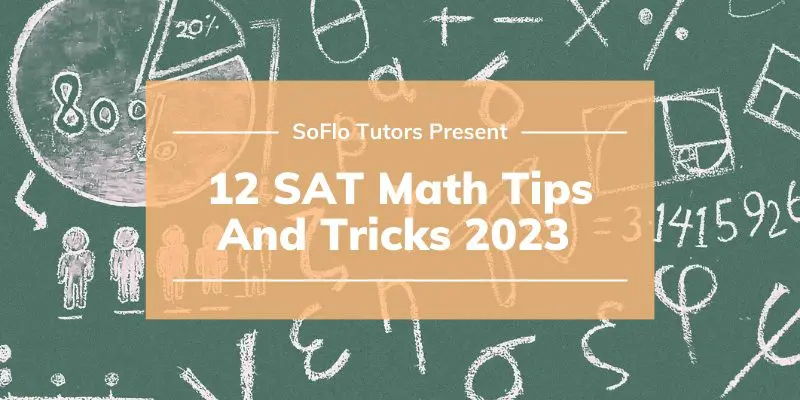
12 SAT Math Tips And Tricks
Does the thought of taking the SAT math section make your stomach churn? Even if you get straight As in class, you might still be stressed about such a huge test! Afterall, knowing the content is different from actually taking the SAT. To calm your nerves, today we’ll be giving you the best SAT math tips and tricks. From better guessing strategies to time management, these tips will help you conquer the math section.
Do SAT Math Strategies, Tips And Tricks Really Work
Following strategic tips and hacks will absolutely help you score higher on the SAT math section – as long as you do your due diligence and study. If you don’t study and practice, no number of tips can help you. Know the material before you start strategizing! Whether it be building an SAT study plan or finding a tutor, make sure you study!
These tips help students approach the test more efficiently, meaning they have more time to answer more questions. Following these strategies will also help students land on the right answer – even if they don’t know how to solve a problem. SAT math tricks basically help you “hack” the test.
SAT Math Tricks For Preparation
We’re going to start giving tips from the very beginning: preparation. Your SAT score isn’t just a reflection of how well you did day of, but also of how well you prepared leading up to the SAT. Follow these tips to boost your studying, and you’ll be in a good place to get a high score.
Familiarize Yourself With The Subjects That Are Being Tested
This might seem super obvious, but make sure that you’re familiar with what’s on the SAT math section. It’ll be hard to score well if you don’t even know what’s on the test, nevermind if you haven’t even practiced.
For the new digital SAT, you’ll need to know:
- Exponents & Radicals
- Exponential Vs. Linear Growth
- Expressions
- Manipulating & Solving Equations
- Systems of Equations
- Word Problems
- Lines
- Quadratics
- Triangles
- Circles
- Trigonometry
- Probability
- Statistics
This list of skills is even shorter than it appears. A lot of these skills are probably things most students regularly practice in class – we’ve all been working with expressions since elementary school!
Knowing what’s actually on the test will help you identify and address what skills or subjects you need to learn about. If you’ve never taken a geometry class you’ll have to learn about triangles, circles, and other related subjects on your own time.
Memorize Common Formulas
Make sure to memorize common formulas and how to use them. While the SAT provides test-takers with a reference sheet at the very beginning of the math section, flipping back and forth to find formulas wastes valuable time – time you could be using to finish the test.
The cheat sheet also won’t give you every single formula you need. Failing to memorize formulas that aren’t provided will cost you easy points. I didn’t memorize the Pythagorean formula for my SAT and simply couldn’t solve two questions – don’t repeat my mistakes!
I promise memorizing formulas is well worth the little time it takes. You probably already have a couple of these down from math class anyways! To make it easier for you, we’ve compiled a list of every formula you should know. Study up on it here.
Take A Practice Test
Taking practice tests is essential to scoring high on the SAT math section! Don’t just take one – try to take at least two timed tests. The more, the merrier. Your score will only continue to improve with practice.
Practice tests will help you figure out and correct your deficits. If you often get questions on the same subject wrong (say, trigonometry), it’s a good indicator that you need to devote more study time to that skill.
Practice tests will also help you manage your time. They’ll help you understand where and what you spend the most and least time on. Knowing this information is crucial to prioritizing and managing questions on the real test.
Be sure you’re taking quality practice tests. Your best practice test resources are official SAT tests from the College Board. Because the College Board actually writes the official tests, their study materials will give you the best idea of what the SAT math section is really like. Practice tests from other online sources won’t always accurately reflect the test.
Work On Your Mistakes And Unknown Questions
To fully gain the benefits of taking practice tests, you need to analyze your mistakes and correct them! If you don’t learn from your mistakes, you will lose those points on the SAT.
After each practice test you take, look over your mistakes, and figure out the right way to approach a question you missed. Being able to recognize mistakes is also valuable practice for when you double-check your real SAT math section.
If you really want to reach for the stars, have someone else grade your test, then try to solve missed questions without knowing the answers.
Work The Hardest On The Topics That Are Most Difficult For You
Be smart with how you spend your studying time! Even if you’re studying for hours every day, this doesn’t matter if you’re not studying the right things. Don’t waste time honing in on subjects you’re really good at – especially if you’re already practicing these skills in school. Instead, focus your time on subjects you struggle with.
If you’re using a prep book to study, pick and choose sections you need work in. Don’t work cover to cover if you can avoid it! This is one of the few times where studying less might actually be better for your score.
SAT Math Tips For Testing
So, you’ve used our SAT math study tips, studied up, and are ready to take the test. Now what? When you actually take the SAT math section, there’s a few hacks you can use to improve your score. Be sure to practice these strategies during practice tests too!
Read The Questions Carefully
This tip might sound simple, but it’s super important! The pressure of a time limit makes it super easy for students to rush through the prompt, misreading what the question is actually asking them to solve for.
The SAT math section might try to trick you with questions like the one above. Don’t fall into their trap – you might find it helpful to underline the question or rewrite what you need to solve so you don’t forget. If you have time left over at the end of the section, re-read the question while you’re reviewing your work.
Use A Calculator
The paper SAT allows test-takers to use their calculators on one of two math sections. The digital SAT lets you use a calculator for the full duration of the math section.
While none of the SAT math problems require students to use a calculator, there’s no shame in reaching for it when you need it! A calculator grants you ease of mind and ensures that you’re getting the right answer. Especially if your mental math isn’t always on point, the calculator can make you quicker and more accurate.
Graphing calculators are particularly useful for quadratic equations and systems of linear equations; use your calculator to solve these questions without having to do any algebra at all. Of course, practice graphing with your calculator at home to prep for test day.
Manage Your Time
As much as the SAT measures your math abilities, it also tests your time-management skills. It doesn’t matter if you know how to solve every single math problem if you don’t have the time to do it.
The new SAT gives you 70 minutes for 44 questions, or just shy of two minutes per question. The old SAT gives students 25 minutes for 20 questions on the no calculator section. This means you’ll have 75 seconds to answer each question. On the calculator section, you’ll have 55 minutes for 38 questions, giving you ~104 seconds per question.
Ideally, you should not spend a full minute on each question. Be as quick as possible, saving up your seconds so you have a) time to double check your answers and b) answer questions you couldn’t figure out the first time around.
You should also strategically prioritize questions! Save harder questions for the end so you have more time to answer everything else accurately. The SAT math section will give you a few questions that, if you don’t know the shortcut for, will drain way too much of your time. If you can’t recognize the shortcut right away, just move on.
Answer Each Question
Never, ever leave a question unanswered – even if you don’t know the answer. The SAT does not dock points for wrong answers. Make your best educated guess. For multiple choice questions, you have a 25% chance of guessing right! Leaving a question blank gives you a 0% chance of getting the point.
Never allow yourself to get discouraged by questions you can’t answer. Keep your cool, save your energy for questions you do know how to answer, and learn to be OK with not knowing.
Don’t Waste Time On Questions You Don’t Know
If you ever encounter a question on an unfamiliar topic, or have no clue how to even approach the problem, don’t sweat it. It’s unfortunate, but no matter how much you study, it can still happen!
Don’t waste time on questions you don’t know. Make a guess, mark the question and come back to it at the end of the test. All questions, regardless of difficulty, contribute the same value to your score – it’s better to answer a lot of easier questions than wasting time on a couple hard questions.
If you’ve managed your time well, you should have time to take another crack at it after finishing everything else in the section.
SAT Math Strategies For Answering
Finally, we’re going to give you the best SAT math strategies for picking the right answer to a question. You might not be 100% certain that your solution is correct – and that’s ok! You can up your odds of getting the problem right with our tips.
Eliminate Wrong Answers
When you’re deliberating between answers on the multiple choice portion of the test, remember that there can only be one clear and right answer. The SAT designs its questions so all incorrect answers are irrefutably wrong – there is no chance that a given question could have two answers.
Ruling out the wrong answers could help you find the right one. You might be able to eliminate answers by logic alone. Others might require some calculation.
Let’s look at this question together. Say you forget or don’t know how to solve a system of equations. You marked the question on your first pass through the test, and now you’re trying to solve it for the second time.
You can plug each of the possible solutions into just one of the original equations. Eliminate the answers that don’t add up; for example, you can eliminate A) because -4+5 does not equal -19.
Choose C If You Don’t Know The Answer
To make the process of elimination quicker, you should always plug in C first. The SAT arranges its multiple choice options from smallest to largest.
If C is wrong, and you know the answer must be bigger, you can eliminate A and B. This leaves D as the right answer.
If C is wrong, but this time you know the answer must be smaller, you can eliminate D. This leaves you to plug in B and A.
Be Confident In Your Abilities On The SAT Math With SoFlo Tutors
Now that you know all the best tips and tricks for the SAT math section, come to SoFlo Tutors for help applying these tips! By starting with a diagnostic test, SoFlo identifies the specific areas a student struggles with. In combination with individualized sessions, SoFlo guides test-takers to their full potential. After just 10 sessions, our students improve by an average of 110 points.
Frequently Asked Questions
What Are SAT Math Tricks For Preparation?
SAT Math tricks for preparation are tips that help you before the test, describing ways to maximize study time. These hacks do not apply to the actual experience of taking the SAT math section.
What Are SAT Math Tips For Testing?
Our SAT Math tops for testing guide test-takers on how to approach any given question on the SAT math section, giving pointers that boost efficiency.
What Are SAT Math Strategies For Answering The Questions?
These tips help test-takers select the right answer to a question, especially if they’re unsure of their own solution. Eliminating answers that are obviously wrong and strategically plugging in solutions will point students to the right answer.
About The Author
Lauren Richards is a sophomore studying narrative at the University of Southern California. She scored a 1510 on the SAT, and in her free time, she enjoys snorkeling, hiking, and all things outdoors.









